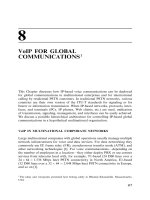VoIP for Global Communications
Bạn đang xem bản rút gọn của tài liệu. Xem và tải ngay bản đầy đủ của tài liệu tại đây (1.01 MB, 10 trang )
8
VoIP FOR GLOBAL
COMMUNICATIONS1
This Chapter discusses how IP-based voice communications can be deployed
for global communications in multinational enterprises and for international
calling by residential PSTN customers. In traditional PSTN networks, various
countries use their own version of the ITU-T standards for signaling or for
bearer or information transmission. When IP-based networks, protocols, inter-
faces, and terminals (PCs, IP phones, Web clients, etc.) are used, unification
of transmission, signaling, management, and interfaces can be easily achieved.
We discuss a possible hierarchical architecture for controlling IP-based global
communications in a hypothetical multinational organization.
VoIP IN MULTINATIONAL CORPORATE NETWORKS
Large multinational companies with global operations usually manage multiple
network infrastructures for voice and data services. For data networking they
commonly use IP, frame relay (FR), asynchronous transfer mode (ATM), and
other networking technologies [1]. For voice communications—depending on
the number of employees in a location—they either deploy PBX or use centrex
services from telecoms local with, for example, T1-based (24 DS0 lines over a
24 Â 64 ¼ 1.536 Mbps line) PSTN connectivity in North America, E1-based
(32 DS0 lines over a 32 Â 64 ¼ 2.048 Mbps line) PSTN connectivity in Europe,
and so on [1].
117
1 The ideas and viewpoints presented here belong solely to Bhumip Khasnabish, Massachusetts,
USA.
If PSTN centrex-based services are used for voice calls, the costs for service
from the telecom may be very high but the on-site maintenance costs will be
low. If PBXs are deployed, two di¤erent network infrastructures must be
maintained—one for data services and the other for voice services—in every
corporate location. This involves two di¤erent sets of monthly bills and two
di¤erent sets of personnel for maintenance and procurement of network ele-
ments such as phones, PBX line cards, routers, switches, UPS, and so on. By
using IP-PBXs and consolidating these two network infrastructures into a sin-
gle IP-based network infrastructure, multinational corporations can reduce
operational expenses, including the expenses related to voice calls, and can
introduce advanced productivity-enhancing services very quickly and economi-
cally, as discussed in detail in Chapter 6.
If circuit-switch or PSTN networking technologies are used to intercon-
nect the PBXs in di¤erent countries, multinational corporations have to find a
PSTN service provider who o¤ers call signaling (including translation) and
media transmission services internationally. Note that for every three E1 links
terminating at a site in Europe, a corporation may need to deploy at least four
T1 links in a North American site. This arrangement is expensive, although it
may provide the flexibility to dial the phones in international locations by using
a one- or two-digit prefix and a five- or seven-digit phone number instead of
using country code, city code, and phone number–based dialing.
By deploying IP-based PBXs and interconnecting them using intercountry
IP links with a guarantee of availability, reliability, security, and performance,
flexibility of dialing and cost savings can be achieved simultaneously. A net-
work of these widely available intercountry IP links can support high-quality
transmission, and can create a global VPN that can be used for voice and data
communications within the corporation across multiple distant LANs.
Figure 8-1a shows the migration of PBX-based telecommunications to an
IP-PBX-based infrastructure in a North American site of a multinational cor-
poration. Figure 8-1b shows the migration of PBX-based telecommunica-
tions to an IP-PBX-based infrastructure at a site in Europe of a multinational
corporation. Note that the telephone sets, their interfaces, and the PSTN-side
trunks are di¤erent in Europe and North America, but the IP phones, their
interfaces, and the IP links are the same all over the world.
Figure 8-2 presents an overall hierarchical architecture for introducing VoIP
service globally using IP-based network. The IP-PSTN MGWs of Figure 3-8
are now replaced by the IP-PBXs. The VoIP GW and CC (Fig. 8-2) control the
resources in the VoIP line cards of the IP-PBX and route the intersite telephone
calls over the IP-based network.
Note that along with the network elements required to support the VoIP
service, the local variants (e.g., North American, European, Japanese) of PSTN
or circuit-switched equipment (e.g., PBX, phones) and wiring can also be
maintained until they fully depreciate. This strategy provides a graceful transi-
tion to an IP-based converged network for both voice and data services. As
described in Chapter 6, the additional network elements required to support
118
VoIP FOR GLOBAL COMMUNICATIONS
Figure 8-1a IP-PBX-based networking infrastructure to support POTS and VoIP ser-
vice simultaneously in a North American location (e.g., Boston, Massachusetts) of a
multinational corporation.
Figure 8-1b IP-PBX-based networking infrastructure to support POTS and VoIP ser-
vice simultaneously in a location in Europe (e.g., Paris, France) of a multinational
corporation.
VoIP IN MULTINATIONAL CORPORATE NETWORKS
119
the VoIP or IP-telephony service within a corporation are IP-PSTN MGWs or
VoIP GWs, VoIP call servers or call managers, IP phones, an uninterrupted
power supply (UPS), and Ethernet and IP switches and routers capable of
supporting the QoS needed for transmission of packetized voice signals in real
time. In addition, when IP version 4 (IPv4)–based addressing is used, network
elements such as firewalls, authentication and key distribution servers, a net-
work address translator (NAT), and so on are also required to resolve many of
the security and authentication problems that corporations are facing today
while trying to use IP for voice communications. Alternatively, IP version 6
(IPv6)–based addressing can be deployed, which supports many of the required
QoS, service, and security and user authentication features. The scalability of
the selected networking technique and the service architecture must also be
carefully analyzed before deployment; these will guarantee that the installed
techniques and architectures satisfy the projected growth requirements of net-
work and service infrastructures.
As mentioned earlier, using intercountry IP links, the IP-PBXs in interna-
tional corporate locations can be interconnected, and a network of these IP
links can create a global IP-VPN for the corporation. Traditional service level
agreement (SLA) parameters for VPNs include availability of bandwidth and
reliability of the link, including mean time to respond and mean time to repair
Figure 8-2 An architecture for a packet-based global network for advanced or
enhanced VoIP and POTS services in a multinational corporation.) (Source: Adapted
from Fig. 3-8)
120
VoIP FOR GLOBAL COMMUNICATIONS
during service outage. However, if the same VPN is used for real-time voice
communications, significant attention must be given to the additional short-
term (i.e., calculated over a short time interval) performance parameters such
as one-way end-to-end (ETE) latency or delay, variation of delay or delay jit-
ter, and percentage of packets lost, as discussed in IETF’s RFCs (RFC 2475
and RFC 3198) and in Chapters 4, 6, and 7. The short time interval is equiva-
lent to the length of a typical real-time voice conversation or session, which
could be 3 to 5 min or longer. The short-term performance parameters not only
determine the availability of a dial tone and the amount of time it takes to
establish a voice call, they also drastically influence the quality of voice signal
transmission during a conversation, as discussed in Chapter 4 in the context of
QoS requirements and in Chapter 6 in the context of NGENs. For example, if
G.711- or PCM-based voice coding—which produces a 64 Kbps bit stream—is
used with a voice sample or packet size of 20 msec, an RTP session bandwidth
of more than 100 Kbps is required (as shown in Fig. 2-2 of Chapter 2), with
no more than 150 msec of one-way ETE (or mouth-to-ear) delay [2], approxi-
mately 20 msec of delay jitter, and 3% of packet loss to support an acceptable
(i.e., a MOS score of 4.0) quality of voice transmission. For example, with 20
msec of delay budget in each of the call access and delivery LANs, only 110
msec is left as the tolerable delay for the intercountry IP link of the global
VPN. It is therefore necessary to actively or passively monitor [3] the inter-
country IP links of the global VPN using the IP network monitoring tools and
utilities (see, e.g., IETF’s RFC 2151) to guarantee the QoS.
In active monitoring, emulated services (e.g., phone calls) between enterprise
sites of interest over one or more in-service intercountry IP links must be
introduced so that the peak and average values of parameters such as dial-tone
delivery and call setup delays, one-way delay, delay jitter, and packet loss
can be measured. Since these measurements introduce additional tra‰c in the
IP links and other network elements (such as MGWs, call servers, and routers),
it is wise to perform these types of tests over several hours unless it is absolutely
necessary to do so at one time.
In passive monitoring, special hardware devices or software probes and
processes such as simple network management protocol (SNMP) traps are
embedded in the network elements to collect information on packet delay, dis-
patch rate, loss, and so on. Additional information on routing and transmis-
sion of call setup, media, and management of tra‰c (or packets) in routers,
switches, VoIP GWs, call servers, and so on is also collected. These statistics
can be retrieved and analyzed periodically from the SNMP management
information base (MIB) for network performance monitoring and capacity
planning purposes. This type of monitoring is more commonly used in enter-
prise networks.
It has also been suggested that voice calls be routed over low-hop-count
(or fewer node) paths [4] in order to guarantee higher transmission quality. This
strategy attempts to minimize the number of nodes in the path from the caller’s
access LAN to the called party’s (i.e., call delivery) LAN, and hence e¤ectively
VoIP IN MULTINATIONAL CORPORATE NETWORKS
121









